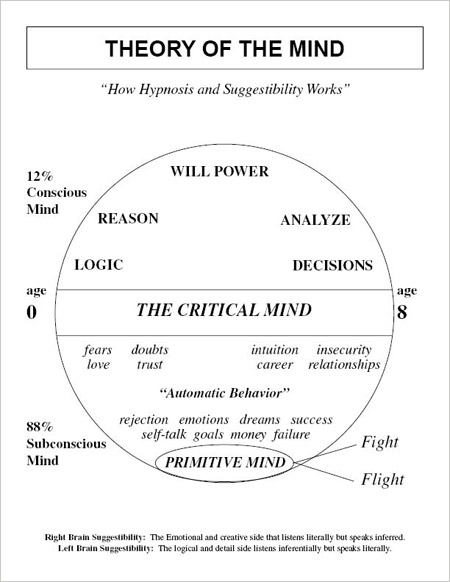How I Became a Hypnotherapist and What is Hypnosis? Episode P448

After 20 years in private practice as a hypnotherapist, Ted reflects on his journey and what it took for him to find his path. Ted also discusses the truth about what hypnosis really is, and what a typical session with a client looks like.
Listen to this podcast episode now:
I have attached a diagram, (courtesy of the Hypnosis Motivation Institute) this is what I use with every new client to explain how hypnosis and hypnotherapy works.

From the time we are born until about 8 years old, we are very suggestible. That just means that we take in everything as absolute truth. As children, we do not have the ability to analyze incoming information; we believe everything we are told. Most kids are walking around in hypnosis.
We learn likes and dislikes, what we are capable of, what we are not capable of, what is fearful, desirable, etc. This is the creation of our so called Life Script: a collection of beliefs and “knowns” that shape our behavior and thinking. This happens at the level of our subconscious mind, so we are not aware that it is occurring. We all fall under the hypnosis of our culture, and adopt the beliefs of our parents, religion and society.
Between 7 and 9 years old, we begin to develop the “critical mind” which blocks suggestions into our subconscious minds. We began to question incoming information, we began to ask why, and to seek to understand the information presented to us. At this point we begin to develop our conscious minds, which we use for decision making, reasoning, analyzing, and logic. We start to think for ourselves.
As you can see from the diagram, the subconscious mind makes up 88% of our total “mind power” according to some estimates. The conscious mind, only about 12%. The subconscious mind has a much greater influence on our behavior.
What brings people into my office is the realization that they have a problem that they cannot seem to solve on their own. For instance, they can’t quit smoking, or get rid of anxiety or get motivated.
The reason for this is that that their subconscious minds contain the programming that keeps them anxious, or procrastinating, or smoking, or overeating. This programming comes from childhood. For instance, in the case of smoking, someone may have seen their parents smoking, saw that they look relaxed when they were smoking, and maybe even saw commercials for smoking. (“Winston tastes good like a cigarette should”)
Their subconscious mind is familiar and comfortable with smoking, to the subconscious, it’s a “known”.
So even though they may want to quit smoking, the part that wants to quit is only 12 %: the conscious mind. But 88% wants to keep smoking. Which do you think will win out? Of course, the 88%.
Hypnosis as a tool for change.
This is where hypnosis comes in. When a person is in hypnosis, their critical mind, whose job is to be the gatekeeper to the subconscious mind, takes a break. They become very suggestible, or, open to suggestion.
So in a hypnotherapy session, I can use the power of suggestion to get the subconscious mind familiar with what the goal is, so that the goal now becomes a “known” to the subconscious mind. With enough repetition and reinforcement, by coming to a few sessions or listening to recordings that I make for my clients, they can begin to reprogram their minds to stop smoking, be more calm and relaxed, or be more motivated. See how that works?
I’ve attached a diagram, (courtesy of the Hypnosis Motivation Institute) this is what I use with every new client to explain how hypnosis and hypnotherapy works.
From the time we are born until about 8 years old, we are very suggestible. That just means that we take in everything as absolute truth. As children, we do not have the ability to analyze incoming information; we believe everything we are told. Most kids are walking around in hypnosis.
We learn likes and dislikes, what we are capable of, what we are not capable of, what is fearful, desirable, etc. This is the creation of our so called Life Script: a collection of beliefs and “knowns” that shape our behavior and thinking. This happens at the level of our subconscious mind, so we are not aware that it is occurring. We all fall under the hypnosis of our culture, and adopt the beliefs of our parents, religion and society.
Between 7 and 9 years old, we begin to develop the “critical mind” which blocks suggestions into our subconscious minds. We began to question incoming information, we began to ask why, and to seek to understand the information presented to us. At this point we begin to develop our conscious minds, which we use for decision making, reasoning, analyzing, and logic. We start to think for ourselves.
As you can see from the diagram, the subconscious mind makes up 88% of our total “mind power” according to some estimates. The conscious mind, only about 12%. The subconscious mind has a much greater influence on our behavior.
What brings people into my office is the realization that they have a problem that they cannot seem to solve on their own. For instance, they can’t quit smoking, or get rid of anxiety or get motivated.
The reason for this is that that their subconscious minds contain the programming that keeps them anxious, or procrastinating, or smoking, or overeating. This programming comes from childhood. For instance, in the case of smoking, someone may have seen their parents smoking, saw that they look relaxed when they were smoking, and maybe even saw commercials for smoking. (“Winston tastes good like a cigarette should”)
Their subconscious mind is familiar and comfortable with smoking, to the subconscious, it’s a “known”.
So even though they may want to quit smoking, the part that wants to quit is only 12 %: the conscious mind. But 88% wants to keep smoking. Which do you think will win out? Of course, the 88%.
Hypnosis as a tool for change.
This is where hypnosis comes in. When a person is in hypnosis, their critical mind, whose job is to be the gatekeeper to the subconscious mind, takes a break. They become very suggestible, or, open to suggestion.
So in a hypnotherapy session, I can use the power of suggestion to get the subconscious mind familiar with what the goal is, so that the goal now becomes a “known” to the subconscious mind. With enough repetition and reinforcement, by coming to a few sessions or listening to recordings that I make for my clients, they can begin to reprogram their minds to stop smoking, be more calm and relaxed, or be more motivated. See how that works?
Want to catch up on previous episodes? Click Here >
Ted had to overcome his own negative programming to enroll in hypnotherapy school and start a private practice. If you need to change your path, or if you are still looking for the right path for you, Ted’s been down that road and can offer support and the subconscious re-programming you need for success. Request a complimentary consultation so that you can get your questions answered and find out if hypnotherapy and high performance coaching is right for you. Go to http://TedMoreno.com/contact, send an email and Ted will get back to you within 48 hours.




